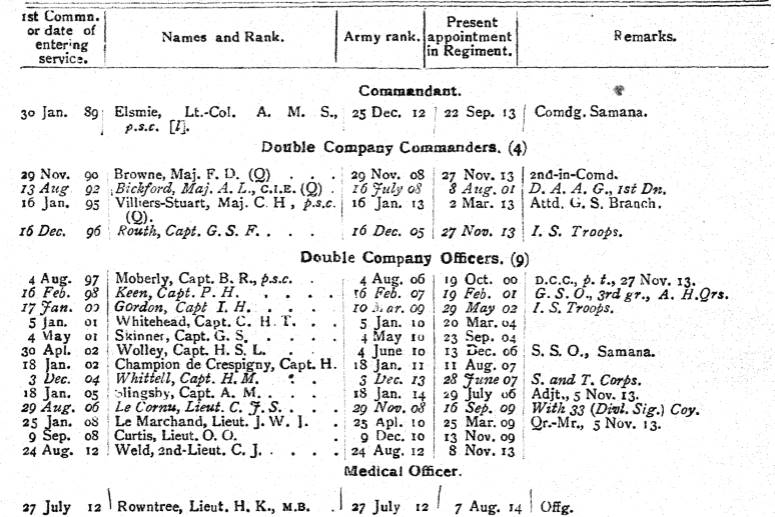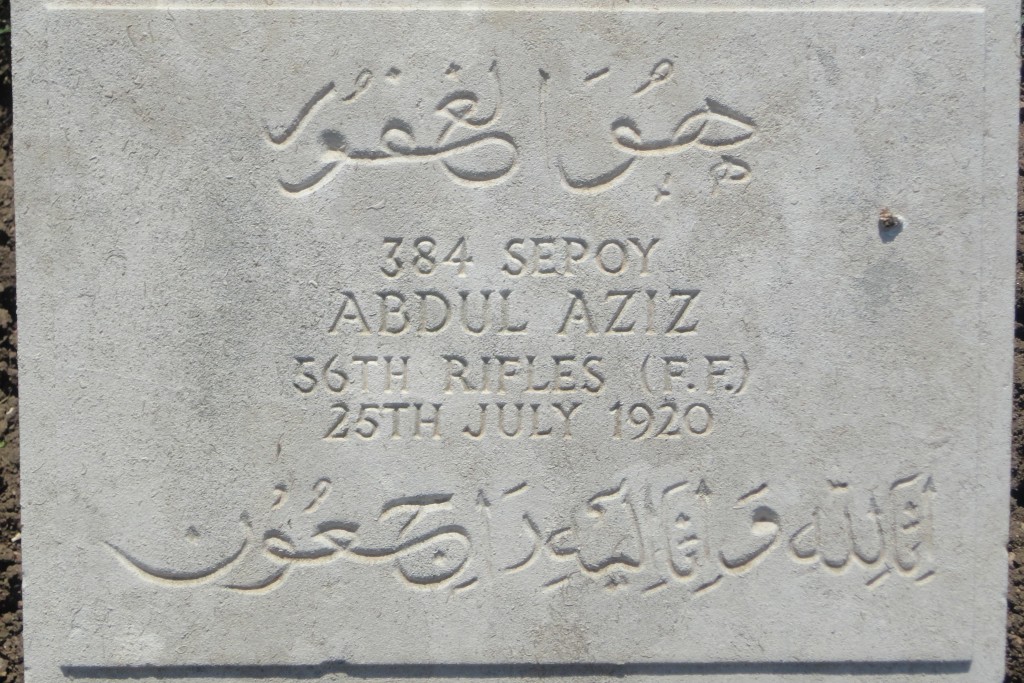This article on the 56th Punjabi Rifles (Frontier Force) aims to help you research either the Regiment or a soldier who served with it during the First World War. I have written a separate article for the war-raised 2nd Battalion 56th Punjabi Rifles (Frontier Force) and a series of guides to help you research soldiers who served in the Indian Army during the war. The links below will take you to the guides:
- 2nd Battalion 56th Punjabi Rifles (Frontier Force)
- Guides to Researching Soldiers who Served in the Indian Army
The 56th Punjabi Rifles (Frontier Force) in the First World War
Lineage: Raised by Lieutenant J. C. Johnston at Mianwali in 1849 from disbanded Sikh Darbar regiments and designated the 2nd Regiment of Punjab Infantry. In 1851 it became the 2nd Regiment of Infantry, Punjab Irregular Force and then in 1865 the 2nd Regiment of Infantry, Punjab Frontier Force. Then in 1901 the 2nd Punjab Infantry and in 1903 the 56th Infantry Frontier Force. In 1906 it was designated the 56th Punjabi Rifles (Frontier Force) and became the 2nd Battalion 13th Frontier Force Rifles in 1922.
Class Composition in 1914: 2 Companies of Sikhs, 2 Companies of Dogras, 2 Companies of Punjabi Muslims and 2 Companies of Khattaks. 1919: 1 Company of Sikhs, 1 Company of Dogras, 1 Company of Punjabi Muslims and 1 Company of Khattaks.
Location in July 1914: The 56th Punjabi Rifles was stationed at Hangu, (Khyber Pakhtunkhwa, Pakistan) having arrived from Kohat (Khyber Pakhtunkhwa, Pakistan) on 7th November 1913.
The 56th Punjabi Rifles (Frontier Force) was stationed at Kohat on the North West Frontier when the First World War began in August 1914. The Regiment was inspected by Major-General F. Campbell, Commanding Kohat Brigade for its confidential report for 1913-14:
The battalion is well officered, well trained and thoroughly ready for any emergency. The rank and file are a fine body of men well turned out. Interior economy very satisfactory and due economy is practised with regard to deduction for clothing.
Health and discipline very good. Drill, manoeuvres, musketry and signalling all very satisfactory. A first rate battalion all round. Fit for active service.
Confidential review reports on Indian Army units for 1913-1914: IOR/L/MIL/7/17023
The extract below was taken from the October 1914 Indian Army List and recorded the British officers serving with the Regiment. The Indian Army List is a very important source of information for researching both regiments and officers of the Indian Army. I have written an article to help you with the jargon you encounter Indian Army Acronyms and Abbreviations.

War Diaries of the 56th Punjabi Rifles (Frontier Force)
There are three war diaries for the 56th Punjabi Rifles (Frontier Force) but only the war diary covering Mesopotamia has been digitized. To download this war diary for a small fee click on the second blue link below which will take you to the National Archives’ website. The other two war diaries can only be viewed at the National Archives. I have copies of all the war diaries and have transcribed some entries below.
- Date: 24 March – 31 December 1915
- 28th Indian Infantry Brigade, 10th Indian Division, Egyptian Expeditionary Force
- Reference: WO 95/4421
- Notes: Overall a poor war diary where the vast majority of days have no entry. However, there are very detailed accounts of the actions on 21st July, 25th August and 25th September 1915, which more than makes up for the rest of the diary.
- Date: 11 January 1916 – 31 December 1917
- 28th Indian Infantry Brigade, 7th (Meerut) Indian Division,
- Reference: WO 95/5141/1
- Notes: A very good war diary for when the Regiment is in action with detailed entries. Some of the later months only have short daily entries.
- Date: 01 January 1918 – 31 March 1920
- 28 Indian Infantry Brigade, 7th (Meerut) Indian Division, Egyptian Expeditionary Force
- Reference: WO 95/4715
- Notes: Overall a poor war diary where the majority of days have no entry. After the Armistice with Turkey, the majority of months are written on a single page. There is a list of British officers serving with the 56th Punjabi Rifles each month.
Further Sources for the 56th Punjabi Rifles (Frontier Force)
If you are researching a British or Indian officer who served with the 56th Punjabi Rifles (Frontier Force) then the Indian Army List can be consulted. A good resource for the Regiment is its confidential reports held at the British Library: Confidential Reports on Regiments etc. These reports also contain the annual reports of the British officers serving with the Regiment. However, when the 56th Punjabi Rifles (Frontier Force) was serving abroad only its Depot and the British officers serving with it were reported on.

The gravestone of Major Charles Herbert Villiers-Stuart, 56th Punjabi Rifles, who was killed in action by a shell when sketching near Anzac Cove on 17 May 1915. Major Villiers-Stuart had joined the 56th Rifles in November 1898 and was acting as Lieutenant General Birdwood’s chief intelligence officer when he was killed. He is buried in Beach Cemetery, ANZAC.

The gravestone of Sepoy Abdul Aziz in the 56th Punjabi Rifles, buried in the Haidar Pasha Cemetery, Istanbul. The son of Goman of Bassi Bahian, of Kote Abdul, Hoshiarpur, Punjab.
Extracts from War Diaries of the 56th Punjabi Rifles (Frontier Force)
01 January 1918 – 31 March 1920, Egyptian Expeditionary Force, WO 95/4715
21 May 1918 – On night of 20/21 enemy attempted a raid on Bedouin Knoll, they did not get beyond our wire, but threw bombs from there, which did not reach our trenches. They put up a red light, whereupon their guns opened fire, then they put up a green light whereupon their guns lifted. No casualties.
19 September 1918 – Marched at 03.00. Brigade formed up near Cromarty Hill 15 minutes before zero (04.30). At 04.30 we advanced. A halt of about one hour took place at Tabsor Hill. After passing the Et Tireh position the brigade went ahead towards Taiyibeh this regiment being advanced guard. A and D companies were vanguard under Captain Evans. The enemy rear guard was first met south of Ayun el Hufiyir. It retired as we advanced finally holding us up on the third ridge. The men were so exhausted from want of water that a halt was made.
A section of machine guns came into action behind out left company and a company from the 53rd Sikhs Frontier Force came up on our left flank. Later a company of the Leicestershires came up and reinforced our right. The enemy commenced to retire, and we advanced (about 16.30) rapidly down to the valley to the railway. Here the enemy held us up for five minutes. He had retired into Taiyibeh in the foothills.
We advanced again and entered Taiyibeh taking up a position covering it. A halt was made here for the night, the regiment bivouacking west of the village.
24 September 1919- Jarabulus – Each company is engaged in making its own lines serviceable for the winter. A and D Companies are mud plastering the roofs and walls of their billets. B Company is making drains in its camp and repairing the floors of the tents. In digging the drains an old Roman earthenware vessel was dug up. It was in a very good state of preservation and probably dated about AD 200. About 2000 bricks are now being made daily.
